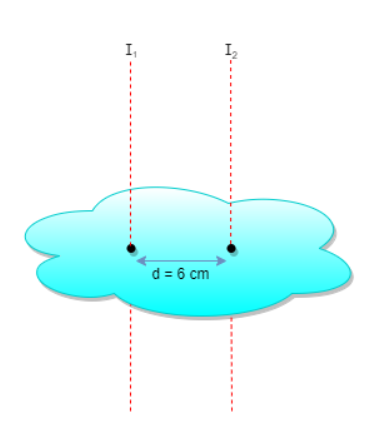
The radius of gyration of a body about an axis at a distance 6cm from its center of mass is 10 cm. Then, its radius of gyration about a parallel axis through its center of mass will be:
A. 80 cm
B. 8 cm
C. 0.8 cm
D. 80 m
Answer
487.8k+ views
Hint: Before attempting this question one should have prior knowledge about the gyration of body and also remember to use parallel axis theorem i.e. ${I_{parallel}} = {I_{cm}} + M{d^2}$here \[{I_{parallel}}\] is the momentum of inertia of body and ${I_{cm}}$ is the momentum about the center and d is the distance between the 2 parallel axes, use this information to approach towards the solution.

According to the given information we have body which have radius of gyration about an axis which is 6cm from its center of mass is 10cm
Before approaching the solution of the question let’s discuss what radius of gyration is?
Radius of gyration can be defined as the imaginary point where it is assumed to exist a concentrated mass of the body from the center of the body and the momentum of inertia at the radius of gyration is assumed to be the same as about the axis of actual mass. The momentum of inertia of a body in terms of radius of gyration is represented as $I = M{k^2}$
Since it is given that the distance of radius of gyration from center of mass is 6 cm
So by the parallel axis theorem we can say that ${I_{parallel}} = {I_{cm}} + M{d^2}$here \[{I_{parallel}}\] is the momentum of inertia of body and ${I_{cm}}$ is the momentum about the center and d is the distance between the 2 parallel axes
Substituting the given values in the above equation
${I_1} = {I_2} + M{d^2}$
Substituting the given values in the above value
$M{\left( 6 \right)^2} = {I_2} + M{\left( {10} \right)^2}$
$ \Rightarrow $${I_2} = M{\left( {10} \right)^2} - M{\left( 6 \right)^2}$
$ \Rightarrow $\[{I_2} = M\left[ {{{\left( {10} \right)}^2} - {{\left( 6 \right)}^2}} \right]\]
$ \Rightarrow $${I_2} = M\left( {100 - 36} \right)$
$ \Rightarrow $${I_2} = M\left( {64} \right)$
$ \Rightarrow $${I_2} = M{\left( 8 \right)^2}$
Comparing the general equation of $I = M{k^2}$ by above equation we get
k = 8 cm
So radius of gyration of axis through the center of mass will be 8 cm
Hence option B is the correct option.
Note: The center of mass that we used in the above solution can be explained as the fixed location relative to an entity or group of objects. This is the average position of all elements of the system, weighted by their masses. The center of mass is found in the centroid, for simple solid structures of uniform density.

According to the given information we have body which have radius of gyration about an axis which is 6cm from its center of mass is 10cm
Before approaching the solution of the question let’s discuss what radius of gyration is?
Radius of gyration can be defined as the imaginary point where it is assumed to exist a concentrated mass of the body from the center of the body and the momentum of inertia at the radius of gyration is assumed to be the same as about the axis of actual mass. The momentum of inertia of a body in terms of radius of gyration is represented as $I = M{k^2}$
Since it is given that the distance of radius of gyration from center of mass is 6 cm
So by the parallel axis theorem we can say that ${I_{parallel}} = {I_{cm}} + M{d^2}$here \[{I_{parallel}}\] is the momentum of inertia of body and ${I_{cm}}$ is the momentum about the center and d is the distance between the 2 parallel axes
Substituting the given values in the above equation
${I_1} = {I_2} + M{d^2}$
Substituting the given values in the above value
$M{\left( 6 \right)^2} = {I_2} + M{\left( {10} \right)^2}$
$ \Rightarrow $${I_2} = M{\left( {10} \right)^2} - M{\left( 6 \right)^2}$
$ \Rightarrow $\[{I_2} = M\left[ {{{\left( {10} \right)}^2} - {{\left( 6 \right)}^2}} \right]\]
$ \Rightarrow $${I_2} = M\left( {100 - 36} \right)$
$ \Rightarrow $${I_2} = M\left( {64} \right)$
$ \Rightarrow $${I_2} = M{\left( 8 \right)^2}$
Comparing the general equation of $I = M{k^2}$ by above equation we get
k = 8 cm
So radius of gyration of axis through the center of mass will be 8 cm
Hence option B is the correct option.
Note: The center of mass that we used in the above solution can be explained as the fixed location relative to an entity or group of objects. This is the average position of all elements of the system, weighted by their masses. The center of mass is found in the centroid, for simple solid structures of uniform density.
Recently Updated Pages
Glucose when reduced with HI and red Phosphorus gives class 11 chemistry CBSE

The highest possible oxidation states of Uranium and class 11 chemistry CBSE

Find the value of x if the mode of the following data class 11 maths CBSE

Which of the following can be used in the Friedel Crafts class 11 chemistry CBSE

A sphere of mass 40 kg is attracted by a second sphere class 11 physics CBSE

Statement I Reactivity of aluminium decreases when class 11 chemistry CBSE

Trending doubts
10 examples of friction in our daily life

The correct order of melting point of 14th group elements class 11 chemistry CBSE

Difference Between Prokaryotic Cells and Eukaryotic Cells

One Metric ton is equal to kg A 10000 B 1000 C 100 class 11 physics CBSE

State and prove Bernoullis theorem class 11 physics CBSE

What organs are located on the left side of your body class 11 biology CBSE




